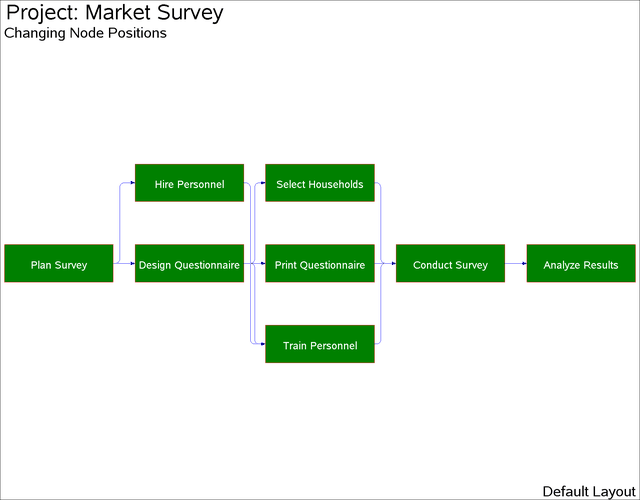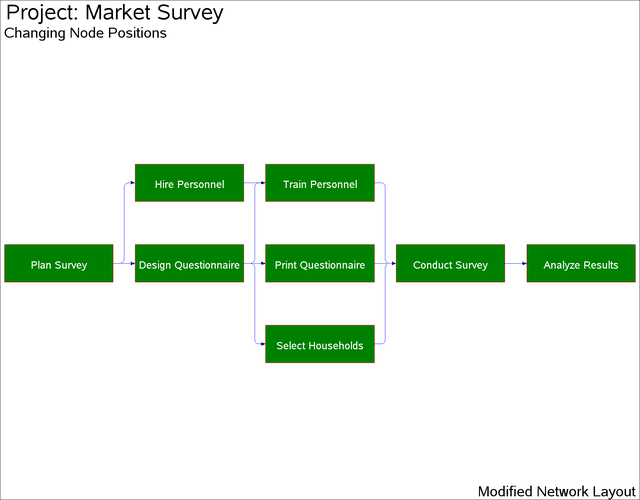The NETDRAW Procedure
- Overview
- Getting Started
-
Syntax

-
Details
 Network Input Data SetVariables in the Network Data SetMissing ValuesLayout of the NetworkFormat of the DisplayPage FormatLayout Data SetControlling the LayoutTime-Scaled Network DiagramsZoned Network DiagramsOrganizational Charts or Tree DiagramsFull-Screen VersionGraphics VersionUsing the Annotate FacilityWeb-Enabled Network DiagramsMacro Variable _ORNETDRComputer Resource RequirementsODS Style Templates
Network Input Data SetVariables in the Network Data SetMissing ValuesLayout of the NetworkFormat of the DisplayPage FormatLayout Data SetControlling the LayoutTime-Scaled Network DiagramsZoned Network DiagramsOrganizational Charts or Tree DiagramsFull-Screen VersionGraphics VersionUsing the Annotate FacilityWeb-Enabled Network DiagramsMacro Variable _ORNETDRComputer Resource RequirementsODS Style Templates -
Examples
 Line-Printer Network DiagramGraphics Version of PROC NETDRAWSpanning Multiple PagesThe COMPRESS and PCOMPRESS OptionsControlling the Display FormatNonstandard Precedence RelationshipsControlling the Arc-Routing AlgorithmPATTERN and SHOWSTATUS OptionsTime-Scaled Network DiagramFurther Time-Scale OptionsZoned Network DiagramSchematic DiagramsModifying Network LayoutSpecifying Node PositionsOrganizational Charts with PROC NETDRAWAnnotate Facility with PROC NETDRAWAOA Network Using the Annotate FacilityBranch and Bound TreesStatement and Option Cross-Reference Tables
Line-Printer Network DiagramGraphics Version of PROC NETDRAWSpanning Multiple PagesThe COMPRESS and PCOMPRESS OptionsControlling the Display FormatNonstandard Precedence RelationshipsControlling the Arc-Routing AlgorithmPATTERN and SHOWSTATUS OptionsTime-Scaled Network DiagramFurther Time-Scale OptionsZoned Network DiagramSchematic DiagramsModifying Network LayoutSpecifying Node PositionsOrganizational Charts with PROC NETDRAWAnnotate Facility with PROC NETDRAWAOA Network Using the Annotate FacilityBranch and Bound TreesStatement and Option Cross-Reference Tables - References
This example uses the SURVEY project described in Chapter 3: Introduction to Project Management, to illustrate how you can modify the default layout of the network. The data set SURVEY contains the project information. PROC NETDRAW is invoked with the GRAPHICS option. The network diagram is shown in Output 9.13.1.
data survey;
format id $20. activity succ1-succ3 $8. phase $9. ;
input id &
activity &
duration
succ1 &
succ2 &
succ3 &
phase $ ;
datalines;
Plan Survey plan sur 4 hire per design q . Plan
Hire Personnel hire per 5 trn per . . Prepare
Design Questionnaire design q 3 trn per select h print q Plan
Train Personnel trn per 3 cond sur . . Prepare
Select Households select h 3 cond sur . . Prepare
Print Questionnaire print q 4 cond sur . . Prepare
Conduct Survey cond sur 10 analyze . . Implement
Analyze Results analyze 6 . . . Implement
;
pattern1 v=s c=green;
title j=l h=3' Project: Market Survey';
title2 j=l h=2 ' Changing Node Positions';
footnote j=r h=2 'Default Layout ';
proc netdraw data=survey graphics out=network;
actnet / act=activity
succ=(succ1-succ3)
id=(id) nodefid nolabel
carcs = blue
ctext = white
coutline=red
centerid
boxht = 3
htext=2
pcompress
separatearcs
ybetween=8;
run;
footnote; title2 'NETWORK Output Data Set'; proc print data=network; run;
The Layout data set produced by PROC NETDRAW (displayed in Output 9.13.2) contains the x and y coordinates for all the nodes in the network and for all the turning points of the arcs connecting them.
Suppose that you want to interchange the positions of the nodes corresponding to the two activities, 'Select Households' and
'Train Personnel.' As explained in the section Controlling the Layout, you can invoke the procedure in FULLSCREEN mode and use the MOVE command to move the nodes to desired locations. In this
example, the data set NETWORK produced by PROC NETDRAW is used to change the x and y coordinates of the nodes. A new data set called NODEPOS is created from NETWORK by retaining only the observations containing node positions (recall that for such observations, _SEQ_ = '0') and by dropping the _SEQ_ variable. Further, the y coordinates (given by the values of the _Y_ variable) for the two activities 'Select Households' and 'Train Personnel' are interchanged. The new data set, displayed
in Output 9.13.3, is then input to PROC NETDRAW.
Output 9.13.2: Layout Data Set
| Project: Market Survey |
| NETWORK Output Data Set |
| Obs | _FROM_ | _TO_ | _X_ | _Y_ | _SEQ_ | _PATTERN | id |
|---|---|---|---|---|---|---|---|
| 1 | plan sur | hire per | 1.0 | 2 | 0 | 1 | Plan Survey |
| 2 | plan sur | hire per | 1.5 | 2 | 1 | . | Plan Survey |
| 3 | plan sur | hire per | 1.5 | 3 | 2 | . | Plan Survey |
| 4 | plan sur | design q | 1.0 | 2 | 0 | 1 | Plan Survey |
| 5 | hire per | trn per | 2.0 | 3 | 0 | 1 | Hire Personnel |
| 6 | hire per | trn per | 2.5 | 3 | 1 | . | Hire Personnel |
| 7 | hire per | trn per | 2.5 | 1 | 2 | . | Hire Personnel |
| 8 | design q | trn per | 2.0 | 2 | 0 | 1 | Design Questionnaire |
| 9 | design q | trn per | 2.5 | 2 | 1 | . | Design Questionnaire |
| 10 | design q | trn per | 2.5 | 1 | 2 | . | Design Questionnaire |
| 11 | design q | select h | 2.0 | 2 | 0 | 1 | Design Questionnaire |
| 12 | design q | select h | 2.5 | 2 | 1 | . | Design Questionnaire |
| 13 | design q | select h | 2.5 | 3 | 2 | . | Design Questionnaire |
| 14 | design q | print q | 2.0 | 2 | 0 | 1 | Design Questionnaire |
| 15 | trn per | cond sur | 3.0 | 1 | 0 | 1 | Train Personnel |
| 16 | trn per | cond sur | 3.5 | 1 | 1 | . | Train Personnel |
| 17 | trn per | cond sur | 3.5 | 2 | 2 | . | Train Personnel |
| 18 | select h | cond sur | 3.0 | 3 | 0 | 1 | Select Households |
| 19 | select h | cond sur | 3.5 | 3 | 1 | . | Select Households |
| 20 | select h | cond sur | 3.5 | 2 | 2 | . | Select Households |
| 21 | print q | cond sur | 3.0 | 2 | 0 | 1 | Print Questionnaire |
| 22 | cond sur | analyze | 4.0 | 2 | 0 | 1 | Conduct Survey |
| 23 | analyze | 5.0 | 2 | 0 | 1 | Analyze Results |
data nodepos; set network; if _seq_ = 0; drop _seq_; if _from_ = 'select h' then _y_=1; if _from_ = 'trn per' then _y_=3; run;
title2 'Modified Node Positions'; proc print data=nodepos; run;
Output 9.13.3: Modified Layout Data Set
| Project: Market Survey |
| Modified Node Positions |
| Obs | _FROM_ | _TO_ | _X_ | _Y_ | _PATTERN | id |
|---|---|---|---|---|---|---|
| 1 | plan sur | hire per | 1 | 2 | 1 | Plan Survey |
| 2 | plan sur | design q | 1 | 2 | 1 | Plan Survey |
| 3 | hire per | trn per | 2 | 3 | 1 | Hire Personnel |
| 4 | design q | trn per | 2 | 2 | 1 | Design Questionnaire |
| 5 | design q | select h | 2 | 2 | 1 | Design Questionnaire |
| 6 | design q | print q | 2 | 2 | 1 | Design Questionnaire |
| 7 | trn per | cond sur | 3 | 3 | 1 | Train Personnel |
| 8 | select h | cond sur | 3 | 1 | 1 | Select Households |
| 9 | print q | cond sur | 3 | 2 | 1 | Print Questionnaire |
| 10 | cond sur | analyze | 4 | 2 | 1 | Conduct Survey |
| 11 | analyze | 5 | 2 | 1 | Analyze Results |
Note that the data set NODEPOS contains variables named _FROM_ and _TO_, which specify the (activity, successor) information; hence, the call to PROC NETDRAW does not contain the ACTIVITY= and
SUCCESSOR= specifications. The presence of the variables _X_ and _Y_ indicates to PROC NETDRAW that the data set contains the x and y coordinates for all the nodes. Because there is no variable named _SEQ_ in this data set, PROC NETDRAW assumes that only the node coordinates are given and uses these node positions to determine
how the arcs are to be routed. The resulting network diagram is shown in Output 9.13.4.
title j=l h=3 ' Project: Market Survey';
title2 j=l h=2 ' Changing Node Positions';
footnote j=r h=2 'Modified Network Layout ';
proc netdraw data=nodepos graphics;
actnet / id=(id) nodefid nolabel
carcs = blue
ctext = white
coutline = red
centerid
boxht = 3
htext=2
pcompress
separatearcs
ybetween=8;
run;

